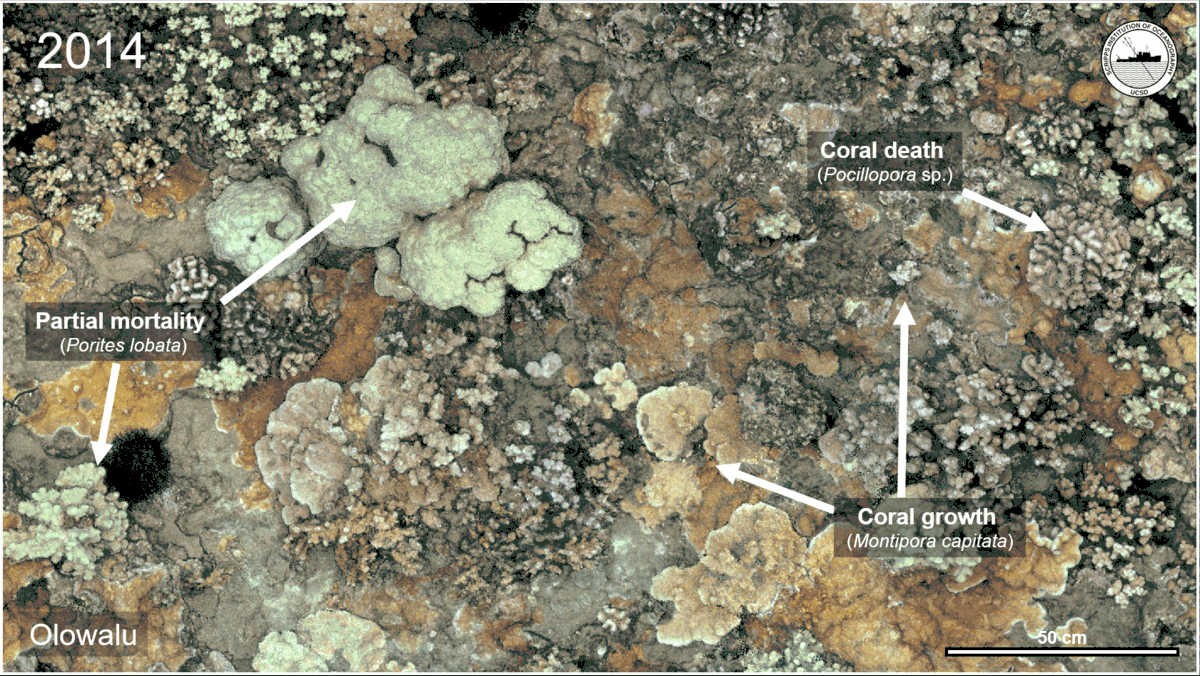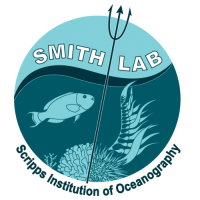Since 2008, the Smith Lab has been conducting a wide range of coral reef research on the island of Maui, Hawaii. This work has primarily focused on understanding dynamics related to community ecology and human impacts on the environment, as well as monitoring oceanographic conditions and reef health.
Benthic Community Ecology (Orion McCarthy; Samantha Clements; Mitchell Smelser; Sarah Romero; Jennifer Smith)
 Maui’s reefs are subject to stress both from local factors (from tourism, fishing, nutrient enrichment, and sedimentation) and global factors (climate change). Maui’s reefs experienced widespread bleaching in 2015 and 2019, which were among the first major bleaching events reported in the Hawaiian Islands. In the future, Maui’s reefs will face an increasing array of acute and chronic stressors, and data on the response of benthic communities to these stressors is critical to inform active management and conservation of coral reef ecosystems.
Maui’s reefs are subject to stress both from local factors (from tourism, fishing, nutrient enrichment, and sedimentation) and global factors (climate change). Maui’s reefs experienced widespread bleaching in 2015 and 2019, which were among the first major bleaching events reported in the Hawaiian Islands. In the future, Maui’s reefs will face an increasing array of acute and chronic stressors, and data on the response of benthic communities to these stressors is critical to inform active management and conservation of coral reef ecosystems.
The Smith Lab began collecting a long-term photographic dataset in 2014 to better understand the effects of both local and global stressors on benthic community dynamics on this heavily populated island. This dataset consists of 20 forereef sites located along the leeward coast of Maui (stretching from Honokowai in the north to La Perouse Bay in the south). In addition, the Smith and Sandin Labs have conducted repeat monitoring of 24 forereef sites surrounding the neighboring islands of Kaho’olawe, Lāna’i, and Moloka’i. At each site, divers take approximately 5,000 pictures of the reef, and then stitch these pictures together into a 3D model using Structure from Motion technology. These models can be used to document the growth, structural complexity, spatial structure, and competitive dynamics of benthic taxa.

Re-visiting these exact locations and reconstructing 3D models of multiple time points provides an unprecedented opportunity to track the dynamics of individual corals and patches of algae. The Smith Lab is using these 3D models to track how reef communities are changing, addressing questions about structural complexity, coral acclimatization to thermal stress, spatial patterning, and benthic competition that are currently unresolved. The Smith Lab is also leveraging this data to address conservation and management challenges in the region.
In addition to collecting benthic imagery, the Smith Lab is studying the genetic structure of corals at select locations in Maui. Many species of corals, particularly those on Maui, display a wide variety of morphologies. Existing on a dramatic continuum, the phenotypes of Porites include differing growth forms, variable color, and varying corallite size and shape. These traits are traditionally used for identification purposes, but the plasticity observed on these reefs, as well as complex fission and fusion dynamics, make it difficult to distinguish between species or identify the boundaries between individual corals. questions of community composition difficult to answer. To address these questions and offer increased resolution of population dynamics, the Smith Lab is using molecular approaches, like RAD-sequencing, to better understand the species boundaries between two key reef building corals: Porites lobata and Porites compressa. Centering around the lab’s long-term monitoring sites, researchers work with large-area imaging technology to map the genetic structure of sampled corals onto 3D coral reef models. With this genetic data, researchers can track individuals over time with increased confidence and even investigate symbiont community shifts in the context of bleaching events. With these findings, the lab hopes to offer greater insight into demographic patterns and changes on reefs as well as inform future conservation management decisions.
Herbivore Communities (Emily Kelly; Levi Lewis; Samantha Clements; Jennifer Smith)
 Coral reefs are dynamic systems with intense competition for space. In particular, constant competition between corals and algae plays a major role in shaping coral reef communities and the services they provide to the fish, invertebrates, and humans who rely on them. The balance between corals and algae is directly impacted by herbivores, which keep algal growth in check. Through a combination of observational and experimental methods, the Smith Lab has assessed the functional redundancy of coral reef herbivore communities, focusing specifically on the dietary preferences and grazing rates of reef fishes and sea urchins. Lab members have used a combination of caging experiments, grazing assays, and bite counts to determine herbivore behavior and stable isotopes to analyze their stomach contents. A subset of this research was conducted in collaboration with the Maui Ocean Center to determine the feeding preferences of herbivorous fish in captivity and the metabolic rates of sea urchins. By determining the ecological roles of different herbivores, this research has enabled us to better understand how many herbivores are needed to balance the growth of algae on a reef.
Coral reefs are dynamic systems with intense competition for space. In particular, constant competition between corals and algae plays a major role in shaping coral reef communities and the services they provide to the fish, invertebrates, and humans who rely on them. The balance between corals and algae is directly impacted by herbivores, which keep algal growth in check. Through a combination of observational and experimental methods, the Smith Lab has assessed the functional redundancy of coral reef herbivore communities, focusing specifically on the dietary preferences and grazing rates of reef fishes and sea urchins. Lab members have used a combination of caging experiments, grazing assays, and bite counts to determine herbivore behavior and stable isotopes to analyze their stomach contents. A subset of this research was conducted in collaboration with the Maui Ocean Center to determine the feeding preferences of herbivorous fish in captivity and the metabolic rates of sea urchins. By determining the ecological roles of different herbivores, this research has enabled us to better understand how many herbivores are needed to balance the growth of algae on a reef.
Environmental Issues (Emily Kelly; Ryota Nakajima; Jennifer Smith)
Coral reefs provide many important benefits to people, including food, coastal protection, revenue, opportunities for tourism and recreation, and natural beauty. However, human activities living in and around coral reefs can impact the underlying ecological dynamics and ultimately lower the capacity for the many ecosystem services which reefs can provide. Sedimentation and runoff from agriculture and coastal development are among the biggest local threats facing coral reefs on Maui. With funding from the US National Fish and Wildlife Foundation, the Smith Lab has worked to quantify changes in sedimentation using a combination of sediment traps and photo-mosaics. Lab members have also provided expertise in a number of applied conservation settings related to runoff, development, and associated environmental impacts. In addition, lab members have used a combination of methods described above to assess herbivore and benthic communities in and around the Kahekili Fisheries Management Area. By comparing herbivore biomass and abundance as well as reef condition across sites with variable levels of protection, this research has helped to better understand the ecological impacts of protected areas. The Smith Lab has also studied the presence of microplastics in marine sediments, both in Maui and across the Pacific Ocean.

